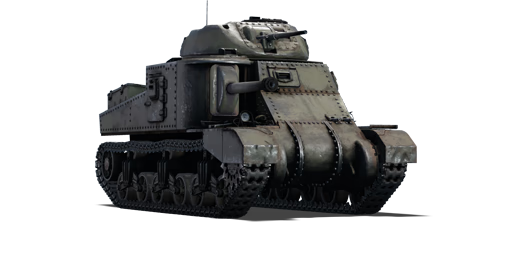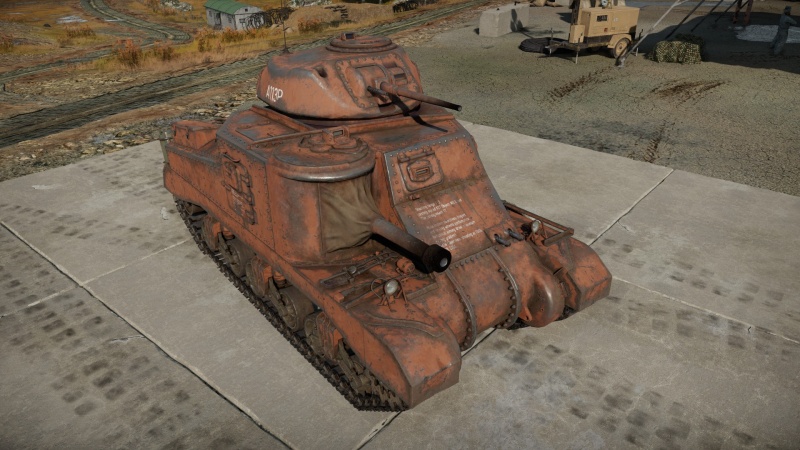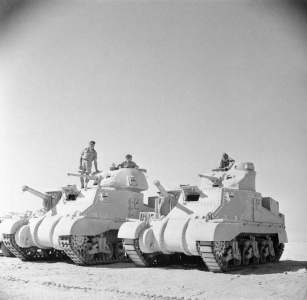Difference between revisions of "Grant I"
m (→Description: SPACE!) |
Colok76286 (talk | contribs) (Edits) |
||
| Line 15: | Line 15: | ||
== Description == | == Description == | ||
<!-- ''In the description, the first part should be about the history of the creation and combat usage of the vehicle, as well as its key features. In the second part, tell the reader about the ground vehicle in the game. Insert a screenshot of the vehicle, so that if the novice player does not remember the vehicle by name, he will immediately understand what kind of vehicle the article is talking about.'' --> | <!-- ''In the description, the first part should be about the history of the creation and combat usage of the vehicle, as well as its key features. In the second part, tell the reader about the ground vehicle in the game. Insert a screenshot of the vehicle, so that if the novice player does not remember the vehicle by name, he will immediately understand what kind of vehicle the article is talking about.'' --> | ||
| − | The '''{{Specs|name}}''' is a premium gift rank {{Specs|rank}} British medium tank {{Battle-rating}}. It was introduced during [[Update 1.61 "Road to Glory"]] as an [[wt:en/news/4151-special-operation-s-u-m-m-e-r-updated-03-08-2016-en|reward vehicle]] for the 2016 [[Operation S.U.M.M.E.R.]] event. It is identical to the | + | The '''{{Specs|name}}''' is a premium gift rank {{Specs|rank}} British medium tank {{Battle-rating}}. It was introduced during [[Update 1.61 "Road to Glory"]] as an [[wt:en/news/4151-special-operation-s-u-m-m-e-r-updated-03-08-2016-en|reward vehicle]] for the 2016 [[Operation S.U.M.M.E.R.]] event. It is identical to the [[Grant I (USA)]], which itself is nearly identical to the [[M3 Lee]] with the difference being in the turret design. |
The Grant is most well recognized for its tall profile and two cannons. The suspension resembles that of the [[M4]] Sherman, the only notable difference being the return rollers' positions. The hull front is also stepped into two plates, where the upper is closer to vertical. The large sponson on the right side (if you are inside it) carriers the main 75 mm gun; note that with 2 crew members, it is the operational gun. The 37 mm gun is in a turret, mounted with a leftward offset. Its main notable difference from the M3 Lee is a redesigned turret. | The Grant is most well recognized for its tall profile and two cannons. The suspension resembles that of the [[M4]] Sherman, the only notable difference being the return rollers' positions. The hull front is also stepped into two plates, where the upper is closer to vertical. The large sponson on the right side (if you are inside it) carriers the main 75 mm gun; note that with 2 crew members, it is the operational gun. The 37 mm gun is in a turret, mounted with a leftward offset. Its main notable difference from the M3 Lee is a redesigned turret. | ||
| Line 311: | Line 311: | ||
;Images | ;Images | ||
| − | + | <gallery mode="packed-hover" heights="200"> | |
| + | File:M3Lee + Grant.jpg|<small>The [[M3 Lee]] (right) and the Grant in the North Africa Theater.</small> | ||
| + | </gallery> | ||
;Videos | ;Videos | ||
Revision as of 17:03, 22 October 2021
| This page is about the gift British medium tank Grant I. For other versions, see M3 Medium (Family). For other uses, see M3 (Disambiguation). |
Contents
Description
The Grant I is a premium gift rank II British medium tank with a battle rating of 2.3 (AB) and 2.7 (RB/SB). It was introduced during Update 1.61 "Road to Glory" as an reward vehicle for the 2016 Operation S.U.M.M.E.R. event. It is identical to the Grant I (USA), which itself is nearly identical to the M3 Lee with the difference being in the turret design.
The Grant is most well recognized for its tall profile and two cannons. The suspension resembles that of the M4 Sherman, the only notable difference being the return rollers' positions. The hull front is also stepped into two plates, where the upper is closer to vertical. The large sponson on the right side (if you are inside it) carriers the main 75 mm gun; note that with 2 crew members, it is the operational gun. The 37 mm gun is in a turret, mounted with a leftward offset. Its main notable difference from the M3 Lee is a redesigned turret.
Due to the presence of two cannons, this tank is an excellent multi-role vehicle. You can play it as a brawler combining the agile 37 mm gun with the high damage of the 75 mm gun, but don't get too close, in fact, the turreted gun has a bad depression and, combined with the high profile, tends to make close tanks difficult to hit. You can also play it as a tank destroyer using it from the second line. Note that you can assign a key to use only one of the two guns, with this method you can select as a primary weapon the 75 mm gun, allowing you to aim directly from it (and not from the point of view of the 37 mm gun) and use the bullet drop indicator in arcade battles.
The multiple cannons allow for different combinations of attack. The 75 mm gun possesses armour penetration on about the level of the 37 mm gun; however, the damage upon penetration is extremely high provided that you use the M61 APCBC shell with HE filler. On the other hand, the 37 mm gun allows for close quarters and longer-range fighting, where its high-velocity and effective shell make for good long range targeting while it is also the only cannon on the Grant that has a full 360-degree traverse.
General info
Survivability and armour
Armour type:
- Rolled homogeneous armour (Hull, Turret roof)
- Cast homogeneous armour (Turret, Transmission area)
| Armour | Front (Slope angle) | Sides | Rear | Roof |
|---|---|---|---|---|
| Hull | 38.1 mm (54°) Front Glacis 50.8 mm (15-55°) Transmission area 50.8 mm (30°) Driver port 38.1 mm (0-57°) Hull gun mount |
38.1 mm (0-22°) Top 38.1 mm Bottom |
38.1 mm (1-14°) Top 38.1 mm (15-53°) Bottom |
12.7 mm |
| Turret | 76.2 mm (1-57°) Turret front 38.1 mm (1-69°) Gun mantlet |
50.8 mm (7-45°) | 50.8 mm (1-35°) | 38.1 mm |
| Cupola | 50.8 mm | 50.8 mm | 50.8 mm | 38.1 mm |
Notes:
- Suspension wheels are 15 mm thick, bogies are 10 mm thick, and tracks are 20 mm thick.
- Hull doors and vision ports are 38.1 mm thick.
- Turret ring is 50.8 mm thick.
Mobility
| Game Mode | Max Speed (km/h) | Weight (tons) | Engine power (horsepower) | Power-to-weight ratio (hp/ton) | |||
|---|---|---|---|---|---|---|---|
| Forward | Reverse | Stock | Upgraded | Stock | Upgraded | ||
| Arcade | 43 | 6 | 27.9 | 620 | 763 | 22.22 | 27.35 |
| Realistic | 39 | 6 | 354 | 400 | 12.69 | 14.34 | |
Modifications and economy
Armaments
Main armament
| 37 mm M5 | Turret rotation speed (°/s) | Reloading rate (seconds) | |||||||||||
|---|---|---|---|---|---|---|---|---|---|---|---|---|---|
| Mode | Capacity | Vertical | Horizontal | Stabilizer | Stock | Upgraded | Full | Expert | Aced | Stock | Full | Expert | Aced |
| Arcade | 128 | -7°/+60° | ±180° | Vertical | 17.1 | 23.7 | 28.8 | 31.8 | 33.9 | 3.77 | 3.33 | 3.07 | 2.90 |
| Realistic | 10.7 | 12.6 | 15.3 | 16.9 | 18.0 | ||||||||
Ammunition
| Penetration statistics | |||||||
|---|---|---|---|---|---|---|---|
| Ammunition | Type of warhead |
Penetration @ 0° Angle of Attack (mm) | |||||
| 10 m | 100 m | 500 m | 1,000 m | 1,500 m | 2,000 m | ||
| M74B1 | AP | 79 | 76 | 65 | 54 | 45 | 37 |
| M51B1/B2 | APCBC | 87 | 84 | 73 | 60 | 50 | 41 |
| Shell details | |||||||||
|---|---|---|---|---|---|---|---|---|---|
| Ammunition | Type of warhead |
Velocity (m/s) |
Projectile Mass (kg) |
Fuse delay (m) |
Fuse sensitivity (mm) |
Explosive Mass (TNT equivalent) (g) |
Ricochet | ||
| 0% | 50% | 100% | |||||||
| M74B1 | AP | 883 | 0.87 | N/A | N/A | N/A | 47° | 60° | 65° |
| M51B1/B2 | APCBC | 883 | 0.87 | N/A | N/A | N/A | 48° | 63° | 71° |
Ammo racks
| Full ammo |
1st rack empty |
2nd rack empty |
3rd rack empty |
4th rack empty |
5th rack empty |
6th rack empty |
7th rack empty |
8th rack empty |
9th rack empty |
Visual discrepancy |
|---|---|---|---|---|---|---|---|---|---|---|
| 128 | 125 (+3) | 121 (+7) | 117 (+11) | 97 (+31) | 74 (+54) | 70 (+58) | 57 (+71) | 27 (+101) | 1 (+127) | Yes |
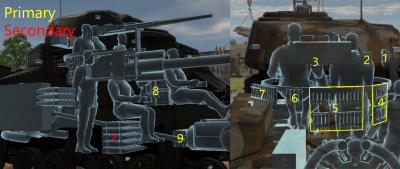
Optics
| Grant I Optics | ||
|---|---|---|
| Default magnification | Maximum magnification | |
| Main Gun optics | x1.85 | x3.5 |
| Comparable optics | M3 Lee | |
Additional armament
| 75 mm M2 | Turret rotation speed (°/s) | Reloading rate (seconds) | |||||||||||
|---|---|---|---|---|---|---|---|---|---|---|---|---|---|
| Mode | Capacity | Vertical | Horizontal | Stabilizer | Stock | Upgraded | Full | Expert | Aced | Stock | Full | Expert | Aced |
| Arcade | 65 | -9°/+20° | ±15° | Vertical | 11 | 16 | 19 | 21 | 23 | 6.50 | 5.75 | 5.30 | 5.00 |
| Realistic | 7.1 | 8.4 | 10 | 11 | 12 | ||||||||
Ammunition
| Penetration statistics | |||||||
|---|---|---|---|---|---|---|---|
| Ammunition | Type of warhead |
Penetration @ 0° Angle of Attack (mm) | |||||
| 10 m | 100 m | 500 m | 1,000 m | 1,500 m | 2,000 m | ||
| M48 shell | HE | 10 | 10 | 10 | 10 | 10 | 10 |
| M72 shot | AP | 84 | 82 | 73 | 62 | 53 | 46 |
| M61 shot | APCBC | 97 | 94 | 84 | 73 | 63 | 55 |
| Shell details | |||||||||
|---|---|---|---|---|---|---|---|---|---|
| Ammunition | Type of warhead |
Velocity (m/s) |
Projectile Mass (kg) |
Fuse delay (m) |
Fuse sensitivity (mm) |
Explosive Mass (TNT equivalent) (g) |
Ricochet | ||
| 0% | 50% | 100% | |||||||
| M48 shell | HE | 448 | 6.3 | 0.4 | 0.5 | 666 | 79° | 80° | 81° |
| M72 shot | AP | 588 | 6.3 | N/A | N/A | N/A | 47° | 60° | 65° |
| M61 shot | APCBC | 588 | 6.79 | 1.2 | 14 | 63.7 | 48° | 63° | 71° |
| Smoke shell characteristics | ||||||
|---|---|---|---|---|---|---|
| Ammunition | Velocity (m/s) |
Projectile Mass (kg) |
Screen radius (m) |
Screen deploy time (s) |
Screen hold time (s) |
Explosive Mass (TNT equivalent) (g) |
| M89 | 259 | 3 | 13 | 5 | 20 | 50 |
Ammo racks
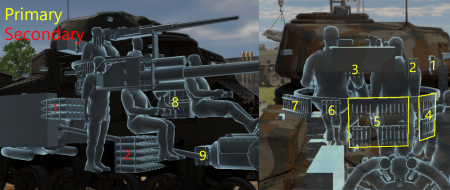
| Full ammo |
1st rack empty |
2nd rack empty |
Visual discrepancy |
|---|---|---|---|
| 65 | 36 (+29) | 1 (+64) | Yes |
Machine guns
| 7.62 mm M1919A4 | ||||
|---|---|---|---|---|
| Mount | Capacity (Belt) | Fire rate | Vertical | Horizontal |
| Coaxial | 4,000 (250) | 500 | N/A | N/A |
Usage in battles
Grant I has a similar playstyle to the M3 Lee and is a multi-turret tank, with a 75 mm gun with a limited field of view placed on the right side hull, and a 37 mm on a fully-traversable turret that can be used separately from the main gun. Compared to the other medium tanks that are equipped with a rotating turret, the Grant I just like M3 Lee has limited gun coverage making the use of 75 mm feel like one is playing a turretless tank destroyer like the StuG III A. But compared to the StuG, Grant I also has a rapid-firing 37 mm M5 cannon that can protect the Grant I from side and rear attacks to buy time for the Grant to turn around to use its deadlier 75 mm M2. It's a medium tank that can be used as both a medium tank and tank destroyer. When fielding the Grant I, one has to be somewhat careful when playing, listen to the surroundings and trying to point the front of the hull so the 75 mm cannon can shoot at the targets that will appear. Getting the transmission or the engine of the Grant I disabled will render it useless to bring its full firepower on the target if it can't turn the hull around to aim its 75 mm on targets. It might have a 37 mm with all around coverage, but the 37 mm will not be 100% efficient against most targets in its BR bracket but it's more useful against lower BR targets where it can penetrate most light targets with certainty.
The main gun of the Grant I is mostly efficient at short to medium range, making it vulnerable to tanks with long 75 mm like Pz.IV F2 and long 50 mm like the Pz.III L that have the accuracy and penetration capability from long distance. Grant I excels mostly in medium to short range where enemy tanks can be reliably penetrated with both the 75 mm and 37 mm. Medium tanks like T-34 can easily shrug off shells from the Grant's 75 mm with its sloped armour, which makes tanks like T-34 to require some more delicate aiming when facing one, aiming for the weak spots on turret cheeks or with luck being able to find one with the side armour exposed. If the Grant is not facing threats from the higher battle ratings, the Grant can dominate the field with its two guns, making it a lethal machine at that battle if properly used.
Different guns mean different styles of play. One can choose to also play it as a tank destroyer, using its sponson gun to take shots at medium range and its 37 mm to cover its flanks and make longer range snipe shots. One can also use it as an assault tank, quickly advancing on points while switching between the powerful 75 mm gun and the faster-firing 37 mm. In all game modes, it would be good to assign the three gun profiles to different keys, this will allow the Grant I to aim using the sights of the three guns separately, allowing it to better performance to the accuracy to hit enemy targets at range with the 75 mm cannon.
The Grant I has the possibility to be facing long-barrelled Pz.III J1, and Pz.IV F2, M4A4, as well as T-34s. The ZiS-30 and Na-To are also very deadly to the Grant I, as well as the threat of heavy tanks like KV-1.
Pros and cons
Pros:
- Ability to use two guns: a 37 mm and a 75 mm, which is very powerful at this rank.
- Fine frontal armour.
- Side mounted 75 mm gives the ability for some unique tactics.
- Despite the tall profile, the "wedding cake" design of the turret has thick sloped armour, providing extra protection to make up for it's height.
Cons:
- Tall profile, big target.
- Side mounted gun - as much it is advantage, it is disadvantage too.
- Slow traverse speeds make it easy for a light or a particularly speedy medium tank to sneak around the sides.
History
Development
After the development of the M2 medium tank, the Battle of France showed that such a tank was not going to be capable to go up against the German Panzer III and Panzer IV. With the Western Allies now embroiled in the North African campaign against the Germans and Italians, the Allies needed a good tank capable of going against the Panzer tanks, and they needed it quickly.
The M3 Lee tank started from the basis of the M2 Medium Tank, using the chassis and the VVSS suspension system. It was to mount the 75 mm cannon, however it was discovered that the United States does not have a turret design that could mount the 75 mm gun. So as development on the turret proceeded, the 75 mm on the M3 would be sponson-mounted. This design was tested on the M2 medium tank as the T5E2, which was approved for the M3 design. The M3 featured a medium tank with two guns, the 75 mm on the hull sponson mount, and a 37 mm with a coaxial machine gun on a turret. The turret cupola also had its own machine gun and there were also two fixed bow machine guns. The use of two gun mounts on a tank was similar to the German Neubaufahrzeug and Soviet T-35 tanks. The M3's 75 mm gun however presented a huge advantage over contemporary tank armaments, as the 75 mm could fire high-explosive rounds for against infantry and anti-tank guns, yet could also fire a shell with a high enough velocity for anti-tank purposes.
The M3's faults were the high profile and the sponson mount for its main armament. The M3 was 10 ft. 3 in. tall, a feet taller than the M2 medium tank. The 75 mm on a sponson mount meant that the main armament of the tank had a limited traverse compared to a rotatable turret and forced the tank to reveal much of its body in order to aim the gun at the enemy. The M3 was also constructed out of rivets (which increased spalling) and had a smooth track design which reduced ground traction. Despite these disadvantages, the British happily accepted them as they were critically low on tanks. German Colonel Hans von Luck said he even considered them superior to the Panzer IVs.
The M3 first saw service with the British in the campaign for North Africa beginning in May, 1942. Those that had been made with a British-designed turret were identified as "Grant", whereas an additional quantity that were Lend-Leased to the British later on with the standard U.S turret were named "Lee." The British cast turret on the Grant was considered superior in terms of frontal protection and replaced the American smoke dischargers with a British smoke mortar, but did not have the cupola or cupola MG of the Lee. The Grant also moved the radio into the turret, removing the need for a separate radio operator position in the hull (the Americans would later do this with their M3s as well). Their baptism of fire was the Gazala battles, where 167 Grants were present with 1st and 7th Armoured Divisions. Regiments with Grants were initially organized on a 2:1 Grants-to-Stuarts, or a 2:1 Crusaders-to-Grants basis, but by 2nd Alamein in October, 1942, Shermans had also been added into that mix. Still, over 170 Grants or Lees were in the line for that battle. There were 3 tanks in a Grant/Lee troop. By May, 1943, all British Grants and Lees were replaced with newer tanks, mostly the Sherman.
Production on the Lee had begun in August 1941. A majority of these were completed at Baldwin Locomotive Works in Philadelphia, Pennsylvania. The British would receive more than their original order of 1,250 tanks. Of the total 6,258 M3s built by the US between start up to the end of production in December 1942, 2,855 units (over 1,600 Grants, and over 1,200 Lees) went to the British and 1,386 Lees went to the Soviet Union, were they served until 1943 before being replaced. A mix of Grants and Lees were also used by the Australians and Indians in the India-Burma theatre, beginning in December, 1943, serving there until the end of the war with Japan. The M3 risked causing confusion in British service as the same "M3" designation was given to the M3 Light Tank. This set off their tradition of naming American-made tanks after generals, where the M3 medium tank earned the name Lee for the American-turret variant (Grant for the British variant) and the M3 light tank was called the Stuart. Americans did not use these names themselves, only starting to name their tanks after the war.
Combat usage
Combat experience with the M3 Lee was complicated, but favorable. In Africa, the Lees and Grants in British and American service surprised the German forces when they could withstand the 50 mm KwK 38 L/42 gun and 75 mm KwK 37 L/24 howitzer armament on the Panzer IIIs and Panzer IVs. The M3 Lee proved reliable and adequate in armour protection. The Soviet's experience with the M3 Lee was less favorable, as their T-34 tanks were much better in combat performance. The Soviets euphemistically called it a "grave for six men" and the Lee tanks were relegated to the secondary fronts or repurposed as armoured personnel carriers. In the Pacific, the M3 Lees were lent to the Australians and Indians, which proved vastly superior to the Japanese tanks in service. The only American use of the M3 Lee at the Pacific Theater was during the Battle of Makin Island.
The M3 Lee served fine as a stop gap solution for the American tank development. They performed very well on the combat field and proved very reliable. However, once a 75 mm turret was finally designed, the M3 Lee was redesigned to use it, and the resulting tank was the M4 Sherman, which will go on to replace the M3 tanks in the Allies as they are withdrawn from service. Even if it wasn't, the M3 was becoming obsolete due to newer German tanks being deployed, such as the Panther, Tiger I, or improvement of of old chassis like Panzer IV Ausf. G and StuG III Ausf. F. Its obsolescence was a consequence of its own rather unique development and anachronistic design, limiting this medium tank's service life to a mere two years in Allied hands. However it lived on until the end of WW2 in the Far East, where it remained superior to Japanese tanks [1] and was ideal as infantry support, for which it had been designed. Approximately 1700 were transferred as soon as they were replaced in North Africa[2]. It also continued in use after modifications such as tractor and recovery vehicles. The chassis and running gear were adapted by the Canadians to develop their Ram medium tank.
An anecdote
- "The 75 (mm gun) is firing. The 37 (mm gun) is firing, but it is traversed round the wrong way. The Browning (machine gun) is jammed. I am saying 'Driver advance' on the A set and the driver, who can't hear me, is reversing. And as I look over the top of the turret and see twelve enemy tanks fifty yards away, someone hands me a cheese sandwich." —British Lieutenant Ken Giles, tank commander of a M3 Grant[3]
Media
- Skins
- Images
The M3 Lee (right) and the Grant in the North Africa Theater.
- Videos
See also
Links to the articles on the War Thunder Wiki that you think will be useful for the reader, for example:
- reference to the series of the vehicles;
- links to approximate analogues of other nations and research trees.
External links
References
- ↑ Burma Grants in Burma theater
- ↑ Transfers to Indian and Australian armies
- ↑ Bell, Chris. "Fury: All You Need to Know about Life in a Tank." The Telegraph. Telegraph Media Group, 24 Oct. 2014. Web. 12 Jan. 2017. Website
| Britain medium tanks | |
|---|---|
| Valentine | Valentine I · Valentine IX · Valentine XI |
| Cromwell | Cromwell I · Cromwell V · Cromwell V (RP-3) |
| Cromwell derivatives | Challenger · Avenger · Comet I · Comet I "Iron Duke IV" · Charioteer Mk VII |
| Centurion | Centurion Mk 1 · Centurion Mk.2 · Centurion Mk 3 · Centurion Mk.5 AVRE · Centurion Mk 10 · Centurion Action X · FV4202 |
| Vickers MBT | Vickers Mk.1 · Vickers Mk.3 · Vickers Mk.7 |
| Chieftain | Chieftain Mk 3 · Chieftain Mk 5 · Chieftain Mk 10 |
| Challenger 1 | Challenger Mk.2 · Challenger Mk.3 · Challenger DS |
| Challenger 2 | Challenger 2 · Challenger 2 (2F) · Challenger 2 TES · Challenger 2 OES · Challenger 2E · Challenger 2 Black Night |
| Challenger 3 | Challenger 3 TD |
| Australia | A.C.I · A.C.IV · Centurion Mk.5/1 |
| South Africa | Olifant Mk.1A · Olifant Mk.2 · TTD |
| India | Vijayanta · Bhishma TWMP |
| Israel | ▄Sho't Kal Dalet |
| Jordan | Khalid |
| Sweden | ▄Strv 81 (RB 52) |
| USA | Grant I · Sherman II · Sherman Firefly · Sherman IC "Trzyniec" |
| Britain premium ground vehicles | |
|---|---|
| Light tanks | A13 Mk I (3rd R.T.R.) · A13 Mk II 1939 · AEC Mk II · Crusader "The Saint" · Rooikat 105 |
| Medium tanks | A.C.I · Grant I · Cromwell V (RP-3) · Sherman IC "Trzyniec" · A.C.IV · Comet I "Iron Duke IV" |
| Centurion Mk.2 · ▄Strv 81 (RB 52) · Centurion Mk.5 AVRE · Centurion Mk.5/1 · ▄Sho't Kal Dalet · Centurion Action X | |
| Vijayanta · Khalid · Challenger DS · Challenger 2 OES | |
| Heavy tanks | Independent · Matilda Hedgehog · Excelsior · TOG II · Churchill Crocodile · Black Prince |
| Tank destroyers | Alecto I · Achilles (65 Rg.) · QF 3.7 Ram |


